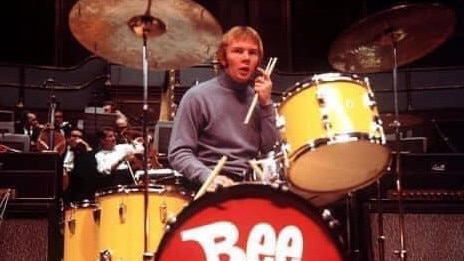Sound-forging Bee Gees’ drummers die just days apart
Dennis Byron’s distinctive playing on Night Fever, You Should Be Dancin’ and the delicate minimalism of Too Much Heaven are works of rock art.

OBITUARY
Colin Petersen
Drummer. Born Kingaroy, Queensland, March 24, 1946; died November 18, aged 78.
Dennis Ronald Byron
Drummer. Born Cardiff, Wales, April 14, 1949; died November 14 aged 75.
Three men could claim to have been the drummer for the Bee Gees: Colin Petersen, his mate from Melbourne Geoff Bridgford, who replaced him in London in 1970, and Dennis Byron. Byron died last week, followed four days later by Petersen.
Petersen drove the rhythm section of the band, joining at the point they were breaking in Britain; Byron was there from 1973 and through the years they were disco’s monarchs and during Barry Gibb’s 1977-78 unmatched nine-month purple patch when he wrote seven Billboard chart-toppers.
Petersen first found fame when he beat 2000 boys to win the starring role in the film Smiley, based on Moore Raymond’s Huckleberry Finn-like story of an outback Queensland kid. It starred Bud Tingwell, Leonard Teale, Chips Rafferty and Sir Ralph Richardson. Petersen was mates with the newly arrived Gibb boys at Queensland’s Humpybong State School.
Like them, Petersen was keen on music and started with piano before moving to drums. He joined a band called Steve and the Board and in 1966 moved to London. Months later the Bee Gees were also there, having charted strongly with the Spicks and Specks single.
Soon enough Petersen was drafted into the band as a full member. The Bee Gees saw themselves as an exclusive club – like the Beatles – but you didn’t need to be family. Petersen married Londoner Joanne Newfield, who was Beatles’ manager Brian Epstein’s secretary and who was present when Epstein was found dead of a drug overdose in 1967. The Bee Gees recorded a song, In the Summer of His Years, as a tribute to Epstein.
Working with Epstein then was Robert Stigwood, who would oversee the Bee Gees’ extraordinary career from that point.
Petersen was behind the kit for some of the band’s greatest moments: New York Mining Disaster 1941, Words, Massachusetts and perhaps the Bee Gees’ most covered song, To Love Somebody.
He reportedly fell out with Stigwood, and left in uncomfortable circumstances, a rift never really repaired.
Byron started on drums as a teenager joining some locals bands in Cardiff before co-founding Amen Corner, which had hits with Bend Me, Shape Me and (If Paradise Is) Half as Nice and disbanded in 1969 after a cover version of the Beatles’ Get Back. He took part in an act spun out of Amen Corner, but in 1972 found himself living in the same London apartment block as Alan Kendall, who had joined the Bee Gees’ band on guitar. He told Byron the band needed a drummer and took him to Barry Gibb’s house where he auditioned for the part.
His timing was impeccable. The Bee Gees were a band in three parts: the trio that left Australia, hired Petersen and former Aztecs guitarist Vince Melouney before that early string of hits; the band that reformed as a trio and scored again with Lonely Days and How Can You Mend a Broken Heart; and the disco-era hits driven by Barry’s falsetto lead vocals that placed nine No.1 hits including Jive Talkin’, You Should be Dancing, Stayin’ Alive and Night Fever.
Along the way Byron brought his old Amen Corner mate Blue Weaver to the Bee Gees in time for him to play a key role on Jive Talkin’ and Nights on Broadway, combining on the latter to help define the band’s sound that was about to change the world.
Across the next five years the Bee Gees became one of the biggest selling acts and Byron was behind the drums for it all. His driving hi-hat pattern on Night Fever and the complexity of his playing on You Should Be Dancin’, the delicate minimalism of Too Much Heaven, are works of rock art. His machine-like leadership on the more than five minutes of Tragedy (another 1979 chart-topper) is an endurance test for most drummers.
Of course many others chased his sounds. The only drummer to influence music more in the 1970s was Jeff Porcaro, whose work with Steely Dan, Boz Scaggs and the band he co-founded, Toto, changed how rock drumming was perceived.
Byron could have played the multiplex drum part in Rosanna, but he wouldn’t have thought of it.
He shared stages with Jimi Hendrix and Pink Floyd and played with many big acts in different fields including Barbra Streisand, Jimmy Ruffin, Kenny Rogers and, of course, Andy Gibb.



To join the conversation, please log in. Don't have an account? Register
Join the conversation, you are commenting as Logout